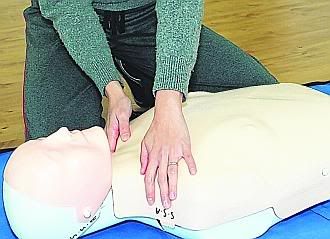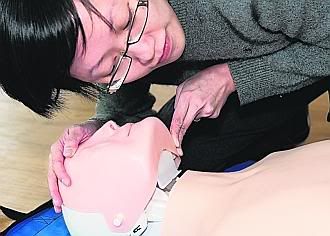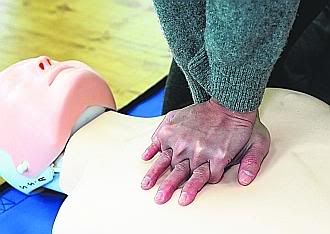26 Sep 2007, ST, Mind Your Body
CPR is key in saving the lives of people in cardiac arrest. Elaine Young finds out why more people should be trained in it
Three weeks ago, 44-year-old Mr Neo Tze Siong made the news when his life was saved by three strangers who gave him cardio-pulmonary resuscitation (CPR) after he had had a heart attack.
A few days later, however, 10-year-old Jonathan Chow Kin Mun's life ended after he fell into a pool, even though he had received CPR from his father.
Why did CPR work for one and not the other?
Unlike the image portrayed on medical dramas, survival with the 'kiss of life' is not guaranteed.
But it is crucial to improving one's chances of surviving should the heart stop suddenly.
According to Singapore General Hospital, each year in Singapore, about 2,400 people develop acute heart attacks, 1,000 suffer from sudden cardiac arrest out of the hospital and another 400 have sudden cardiac arrest after reaching the hospital.
But only one in five people who suffers a cardiac arrest receives CPR, noted Mr Robin Tan, chief trainer at SGH's Life Support Training Centre.
The total survival rate for pre-hospital collapses is about 2.6 per cent.
If the victim is to have a chance, the Chain of Survival, developed in 1990 by the American Heart Association (AHA) must be swiftly followed. This protocol addressed the fact that most sudden cardiac arrest episodes occur outside a hospital, with death occurring within minutes. There are four links in the chain: early recognition and access, early CPR, early defibrillation and early advanced care in hospital.
To be effective, each link in the chain has to be executed quickly. With each minute that passes, the chance of survival decreases by up to 10 per cent.
The most common reason for a person to die suddenly from cardiac arrest is heart disease. Other causes of cardiac arrest include foreign body obstructions in the airway, drowning, stroke, suffocation, smoke inhalation and electrocution.
During a heart attack, the heart continues to pump blood, but part of the organ does not receive any blood because of a clot which suddenly and completely blocks blood flow to the heart.
If the person who has a heart attack collapses, is not breathing and has no pulse, then it is a cardiac arrest. This is when the heart rhythm becomes rapid or chaotic, so it cannot pump oxygenated blood efficiently to the brain, lungs, and other organs. This is known as ventricular fibrillation. The victim quickly stops breathing and loses consciousness.
'A person who has sudden cardiac arrest has very little time before brain damage occurs - approximately four minutes - so time is of the essence,' said Dr Lim Chong Hee, senior consultant at the department of cardiothoracic surgery at the National Heart Centre of Singapore.
The idea of CPR is to get the circulation going 'artificially', he explains. This includes providing mouth-to-mouth resuscitation and chest compression.
Chest compression mimics heart contractions and mouth-to-mouth mimics breathing, by delivering oxygen to the lungs via the mouth.
CPR is the second link in the Chain of Survival. It is the link that can buy life-saving time between the first (early access to emergency care) and third link (early defibrillation).
To defibrillate the heart is to give it an electric shock which stops it, so it can restart.
According to the AHA, few attempts at resuscitation are successful if CPR and defibrillation are not provided within minutes of the collapse.
Said Dr Lim: 'CPR can restore normal heart rhythm, especially when you are able to institute defibrillation.'
There are some risks to CPR: Even if done correctly, it could result in complications such as fractured ribs. It should also not be attempted if the person is still breathing and has a pulse, but mistakes are minimised if the rescuer is properly trained in CPR.
It is also not as effective without defibrillation but it helps to buy time by getting blood to the brain and other organs before emergency paramedics arrive, said Dr Lim.
All emergency civil defence ambulances are equipped with automatic external defibrillators (AEDs), which are portable electric shock devices. At the moment, these are not widely available - at about $3,000 per kit, that is perhaps no surprise - but this is another goal for the Singapore Heart Foundation.
Said Mr Muhammad Khair, executive officer of community education with the foundation: 'These machines are already in clinics, hospitals and ambulances but we would like to see them in every shopping centre, HDB void deck and MRT station.'
In tandem with getting more AEDs into the community, the foundation wants to see half the Singapore population - up from the current two in 10 - trained in CPR and in the use of AEDs over the next three years.
About 30,000 people, mainly health-care professionals and emergency workers, receive CPR training here every year. But that includes those who take the refresher course after two years.
This number is woefully small, considering 90 per cent of sudden attacks occur either at home or in public places, so a person's best chance of survival could be from a family member or stranger.
Said Dr Lim: 'CPR training is easily accessible and should be promoted as public education.'
Dr Patrick Tan from the Singapore Red Cross Medical Commission concurs: 'The public mindset must change from apathy and the belief that learning CPR and AED is other people's responsibility.
'Everyone should make it a point to learn CPR and AED. Don't wait for an emergency to happen and regret not knowing what to do to save a life.'
CPR is key in saving the lives of people in cardiac arrest. Elaine Young finds out why more people should be trained in it
Three weeks ago, 44-year-old Mr Neo Tze Siong made the news when his life was saved by three strangers who gave him cardio-pulmonary resuscitation (CPR) after he had had a heart attack.
A few days later, however, 10-year-old Jonathan Chow Kin Mun's life ended after he fell into a pool, even though he had received CPR from his father.
Why did CPR work for one and not the other?
Unlike the image portrayed on medical dramas, survival with the 'kiss of life' is not guaranteed.
But it is crucial to improving one's chances of surviving should the heart stop suddenly.
According to Singapore General Hospital, each year in Singapore, about 2,400 people develop acute heart attacks, 1,000 suffer from sudden cardiac arrest out of the hospital and another 400 have sudden cardiac arrest after reaching the hospital.
But only one in five people who suffers a cardiac arrest receives CPR, noted Mr Robin Tan, chief trainer at SGH's Life Support Training Centre.
The total survival rate for pre-hospital collapses is about 2.6 per cent.
If the victim is to have a chance, the Chain of Survival, developed in 1990 by the American Heart Association (AHA) must be swiftly followed. This protocol addressed the fact that most sudden cardiac arrest episodes occur outside a hospital, with death occurring within minutes. There are four links in the chain: early recognition and access, early CPR, early defibrillation and early advanced care in hospital.
To be effective, each link in the chain has to be executed quickly. With each minute that passes, the chance of survival decreases by up to 10 per cent.
The most common reason for a person to die suddenly from cardiac arrest is heart disease. Other causes of cardiac arrest include foreign body obstructions in the airway, drowning, stroke, suffocation, smoke inhalation and electrocution.
During a heart attack, the heart continues to pump blood, but part of the organ does not receive any blood because of a clot which suddenly and completely blocks blood flow to the heart.
If the person who has a heart attack collapses, is not breathing and has no pulse, then it is a cardiac arrest. This is when the heart rhythm becomes rapid or chaotic, so it cannot pump oxygenated blood efficiently to the brain, lungs, and other organs. This is known as ventricular fibrillation. The victim quickly stops breathing and loses consciousness.
'A person who has sudden cardiac arrest has very little time before brain damage occurs - approximately four minutes - so time is of the essence,' said Dr Lim Chong Hee, senior consultant at the department of cardiothoracic surgery at the National Heart Centre of Singapore.
The idea of CPR is to get the circulation going 'artificially', he explains. This includes providing mouth-to-mouth resuscitation and chest compression.
Chest compression mimics heart contractions and mouth-to-mouth mimics breathing, by delivering oxygen to the lungs via the mouth.
CPR is the second link in the Chain of Survival. It is the link that can buy life-saving time between the first (early access to emergency care) and third link (early defibrillation).
To defibrillate the heart is to give it an electric shock which stops it, so it can restart.
According to the AHA, few attempts at resuscitation are successful if CPR and defibrillation are not provided within minutes of the collapse.
Said Dr Lim: 'CPR can restore normal heart rhythm, especially when you are able to institute defibrillation.'
There are some risks to CPR: Even if done correctly, it could result in complications such as fractured ribs. It should also not be attempted if the person is still breathing and has a pulse, but mistakes are minimised if the rescuer is properly trained in CPR.
It is also not as effective without defibrillation but it helps to buy time by getting blood to the brain and other organs before emergency paramedics arrive, said Dr Lim.
All emergency civil defence ambulances are equipped with automatic external defibrillators (AEDs), which are portable electric shock devices. At the moment, these are not widely available - at about $3,000 per kit, that is perhaps no surprise - but this is another goal for the Singapore Heart Foundation.
Said Mr Muhammad Khair, executive officer of community education with the foundation: 'These machines are already in clinics, hospitals and ambulances but we would like to see them in every shopping centre, HDB void deck and MRT station.'
In tandem with getting more AEDs into the community, the foundation wants to see half the Singapore population - up from the current two in 10 - trained in CPR and in the use of AEDs over the next three years.
About 30,000 people, mainly health-care professionals and emergency workers, receive CPR training here every year. But that includes those who take the refresher course after two years.
This number is woefully small, considering 90 per cent of sudden attacks occur either at home or in public places, so a person's best chance of survival could be from a family member or stranger.
Said Dr Lim: 'CPR training is easily accessible and should be promoted as public education.'
Dr Patrick Tan from the Singapore Red Cross Medical Commission concurs: 'The public mindset must change from apathy and the belief that learning CPR and AED is other people's responsibility.
'Everyone should make it a point to learn CPR and AED. Don't wait for an emergency to happen and regret not knowing what to do to save a life.'
-----------------------------------
Chances of survival
The chances of survival range from zero to 43per cent, depending on the type and speed of attention:
No care after collapse
0%
No CPR and delayed defibrillation
(after 10 minutes)
0 to 2%
CPR from a non-medical person
(bystander or family member)begun within two minutes,but delayed defibrillation
2 to 8%
CPR and defibrillationwithin eight minutes
20%
CPR and defibrillationwithin four minutes; paramedichelp within eight minutes
43%
------------------------------------





The general sequence of CPR (not all steps are shown): First, establish unresponsiveness by tapping the casualty on the shoulder.
Then, check for foreign objects in mouth, and flick any out with index finger. Check for breathing and feel for the flow of air from the casualty’s nose moving past your cheek. If victim is not breathing, give two short breaths and allow for lung deflation between breaths.
Finally, interlace fingers as shown, use body weight to compress chest. Perform 30 compressions.
-----------------------------------
CPR courses
The National Resuscitation Council was established in 1998. It is the accreditation body for all cardiac life support training centres in Singapore.
The National Heart Centre website (www.nhc.com.sg) lists all the accredited CPR Training Centres. Here are some heartsaver courses on offer for the public:
>>Changi General Hospital
Training Centre
Duration: 4.5 hours
Cost: $52.50
Course outline: CPR guide. Theory and practical test.
Inquiries: Call 6850-2360 or go to website www.cgh.com.sg
>>Singapore General Hospital
Life Support Training Centre
Duration: 3 hours
Cost: $53.50
Course outline: CPR guide. Participants can go on to do the four-hour AED course on the afternoon of the same day. Theory and practical test.
Inquiries: Call 6326-6884 or e-mail lstc@sgh.com or go to website www.sgh.com.sg
>>Singapore Red Cross Society
Training Centre
Duration: 8 hours (includes 120 minutes for lunch/breaks)
Cost: $90
Course outline: CPR guide. Theory and practical test.
Inquiries: Call 6336-0269 or go to website www.redcross.org.sg


No comments:
Post a Comment